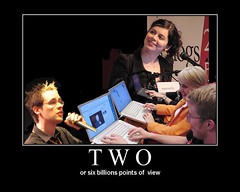A while back Laura twittered that she was looking for ideas for an upcoming gathering on technology for non profits. She asked what we thought in response to a blog post she put up… Getting the most from social media for nonprofits: what would you recommend? I started getting all carried away in her comments, writing something that was waaaay too long for a comment and promised to write a blog post about it. Nearly two weeks later, here I am…
First, here is what I wrote:
Sounds like you have a great team! I wish I were a fly on the wall.
I had a long conversation about this topic at lunch yesterday with Jim Benson. My takeaway reinforces my takeaway about doing ANYTHING online or offline. What is the purpose? The availability of social media can be used as a reminder to ask ourselves what we are trying to accomplish in our NGOs/NPOs. Is it a communication need? A collaboration need? Do we need to find ways to be more inclusive? Do we need to expand the reach of our message? Do we want to develop more trust for better, longer lasting volunteer relationships. How do we flip the conversation so we come at the media with a clear and compelling motivation. (That said, hearing great examples/stories from other NPOs is very motivating to generate possibilities around purpose!!)
This same question comes up when communities of practice ask “what technology should we use.” Etienne Wenger, John Smith and I are on the home stretch (fingers crossed) of the book we are writing and we have written about some ways to look at your org and ask the strategic questions first, then turn to the technology. So for example….
(Oops, this is getting preachy and long winded. And on YOUR blog. Uh oh. I should probably do a blog post and link here!! Wait! Wait! I’ll go do that. I’ll come back and post a link. After breakfast. Mommy wants coffee!)
Jeeze, that was a long breakfast. Clearly I missed the coffee.
What I was starting to write about was a strategy to evaluate technology not unto itself, but in the context of a need, an activity a non profit wants to support. That starts with looking at the organization. What are it’s key activities? With whom? THEN look at how technology can support them.
Of course, it is fun to see new tools, particularly when introduced with a case or story about how another non profit has used them. We need these to stimulate our creativity and imagination. But our organizations and peers are going to clobber those of us with the “early adopter” syndrome for bringing back more toys and less context than they can tolerate. So the discipline of asking “what for” is essential.
Second, I was going to strongly support Laura’s inclination to do some version of the Social Media Game that David Wilcox and Beth Kanter cooked up last year. I have used it a couple of times and each time I learn more. What is great is the engagement and conversation the game stimulates. But again, sometimes I erred on the side of too many toys and not enough focus.
Reading further in the comments that piled up since I first jumped in, I found myself nodding in strong agreement with the tension organizations might feel about splitting the attention of constituents who are “members” of both the organization and of all these newfangled social networking sites (a.k.a Facebook, Bebo, etc.) Why should I fracture my organization’s presence and identity at more than my own website? What does this do to the organization’s identity? The individual’s sense of identity and association with the organization? I think these are huge questions and I look forward to hearing what people figure out.
As to more resources, I keep piling up more on my wiki. Check the recent changes page!


 his friends I my job was to overthrow small countries. It was easier than explaining what I do. So it was with joy to see my sister in law, Linda Wright, take the plunge and create an online adjunct to her new book,
his friends I my job was to overthrow small countries. It was easier than explaining what I do. So it was with joy to see my sister in law, Linda Wright, take the plunge and create an online adjunct to her new book,